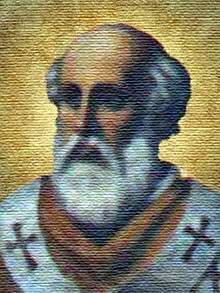
Pope Adeodatus I
Pope Adeodatus I (died 8 November 618), also called Deodatus I or Deusdedit, was Pope from 19 October 615 to his death in 618.
Biography
He was born in Rome, the son of a subdeacon. He served as a priest for 40 years before his election and was the first priest to be elected pope since John II in 533. Adeodatus represents the second wave of anti-Gregorian challenge to the papacy, the first being that of Sabinian. He reversed the practice of his predecessor Boniface IV of filling the papal administrative ranks with monks by recalling the clergy to such positions and by ordaining some 14 priests, the first ordinations in Rome since Pope Gregory.
In August 618, an earthquake struck Rome, followed by an outbreak of a scab disease, during which Adeodatus died. There was a vacancy of one year, one month, and 16 days before his successor was consecrated.
According to tradition, he was the first pope to use lead seals (bullae) on papal documents, which in time came to be called "papal bulls". One bulla dating from his reign is still preserved, the obverse of which represents the Good Shepherd in the midst of His sheep, with the letters Alpha and Omega underneath, while the reverse bears the inscription: Deusdedit Papæ.
Pope Adeodatus
Pope Adeodatus can refer to:

Pope Adeodatus II
Pope Adeodatus II (died 17 June 676), also known as Deodatus II, was Pope from 11 April 672 to his death in on 17 June 676. Little is known about him. Most surviving records indicate that Adeodatus was known for his generosity, especially when it came to the poor and to pilgrims. He was preceded by Vitalian and succeeded by Donus, and devoted much of his papacy to improving churches.
Biography
Born in Rome, he became an Order of Saint Benedict monk of the Roman cloister of St Erasmus on the Caelian Hill. He was active in improving monastic discipline and in the repression of Monothelitism and gave Venice the right to choose the doge itself. During his pontificate the basilica of St. Pietro at the eight milestone of Via Portuense. St Erasmus was also reconstructed. Elected as Pope on 11 April 672, Adeodatus II did not get involved in political events and disengaged himself from the events at the time surrounding monothelitism.
Pope Adeodatus II devoted his reign to the restoration of churches in disrepair. He protected the Abbey of St. Peter and St. Paul (known as St. Augustine's Abbey), exempted Marmoutier Abbey, Tours (Abbey of St. Martin of Tours) from the authority of the Holy See, and led improvements to St. Erasmus' monastery. He is sometimes referred to with the title Saint and 26 June is attributed as his feast day, but this is disputed. When his papacy began, Adeodatus II was already an elderly man, and even though he reigned for four years, it is considered that his papacy did not contribute by a large amount to society. Pope Adeodatus II died on 17 June 676.
Podcasts:

